2024 BMW R 1300 GS Review – First Ride

Smaller, faster, more complex
An R 1300 GS has never existed until now. An obvious statement, but truly, this is a new motorcycle that, while carrying with it the spirit of what the BMW GS name embodies, is delivered in a completely new way. The 1300 GS is like no motorcycle that has come before it wearing the storied moniker. It’s not built upon its predecessor, but rather it’s a ground up redesign of a very important motorcycle.
2024 BMW R 1300 GS
BMW has brought a ground up redesign of what its flagship is and should be with the R 1300 GS. We’re going to need more seat time for a thorough test.
Editor's score: 89.5%
Engine | 18.5/20 | Suspension | 14.0/15 | Transmission | 7.5/10 |
Brakes | 8.5/10 | Instruments | 4.0/5 | Ergonomics | 9.5/10 |
Appearance | 9.5/10 | Desirability | 9.5/10 | Value | 8.5/10 |
Highs
- More compact and powerful engine
- Better rider feedback from the chassis
- Overall smaller and lighter
Sighs
- A dizzying array of options
- It’s probably going to be difficult to find a base model without custom ordering
- One day of testing isn’t enough
Motorcycle.com would like to thank Motorcycle Mechanics Institute | MMI for sponsoring this video.
After adding to the previous GS over the years, making changes, some big, some small, the bike had become an amalgamation of accoutrement that added up to an excellent touring motorcycle. There’s nothing wrong with that and surely BMW has the sales numbers to back up that claim – the company actually cited 2022 as its best sales year yet with more than 200,000 units sold. At some point though, the dam has to break and something’s got to give. How and when does a manufacturer decide to start with an entirely clean slate to recreate its most important motorcycle from the ground up? Well, for BMW, that time was seven years ago, and what you see here is the result of nearly a decade of engineering and design.
We’ll begin from the core and work our way out as we explore how BMW recreated its iconic adventure motorcycle – and naturally, what it’s like to ride.
Light Heavyweight
Lighter weight, more compact, and perhaps most importantly, more power – three key features of the GS that also happen to apply to the new Boxer engine propelling the latest member of the Gelände Straße family. Losing weight isn’t easy. Dropping weight and adding muscle is even tougher. Yet BMW has managed to pull it off with the GS’s new 1300 cc power plant.
Increasing the bore by 4 mm and decreasing the stroke by 3 mm along with a higher compression ratio (up to 13.3:1 from 12.5:1) has BMW claiming 145 hp at 7,750 and 110 lb-ft of torque at 6,500 rpm. Not surprisingly, BMW’s Shiftcam technology was carried over for optimizing valve lift and stroke at varied loads. The intake valve is quite a bit larger at 44 mm with the exhaust side bumped up a smidge as well to 35.6 mm (up from 40 mm and 34 mm respectively). The 52 mm throttle bodies are a couple of the only things to be carried over from the 1250 GS.
In repackaging the engine, BMW moved the transmission from behind the engine to below it thus creating a much shorter package from front to back. They also managed to keep the center of gravity the same by removing a third shaft driving the transmission which has, in turn, allowed ground clearance to stay the same and the actual height of the engine to be almost exactly the same, too. We’re told the engine is slightly more forward biased overall. In the reworking of the engine/transmission, astute GS-ianados may notice upon standing over the bike that the cylinder heads are now totally symmetrical thanks to BMW placing the timing chains on opposing sides of the cylinders.
I don’t think there’s a GS owner or ADV rider in general who wouldn’t appreciate an open-class adventure bike getting smaller, and of course in BMW’s case, this started at the engine and has had an effect on the bike as a whole. Riding the R 1300 GS, the engine produces a familiar, yet much stronger mid-range rush, although, after minimal time riding the bike, it feels like it may have lost a bit of torque right off idle perhaps due to the shorter stroke. Although the bike feels far sportier when ridden with anger, it hasn’t lost its ability to deliver a more docile and mature touring experience and it’s still quite easy to ride off-road, whether you’re picking through rocks or drifting around corners. It does all this very smoothly, too. There are very little vibes making their way out of that motor.
This table will tell you everything they want you to know about ride modes and what they affect on the R 1300 GS (click to enlarge on desktop; touch to scroll on mobile):
In standard trim, the 1300 GS gets four ride modes including Eco, Rain, Road, and Enduro. As before, Ride Modes Pro are optional (but you’ll want those) and include Dynamic, for sporty riding, Dynamic Pro, for adjustable sporty riding, and Enduro Pro, for adjustable sporty riding off-road. The difference between Dynamic and Road mode is vast, which I think we can all appreciate – there’s no reason for six ride modes if you can barely tell the difference. Dynamic gives a much more precise and instantaneous throttle response which lets you get into the 1300’s brawny mid-range that much quicker.
The switchgears have also been modified to be far more customizable with long presses, short presses, and favorite buttons. The entire bike is a lot to take in the first time you swing a leg over it, but these features – once you’ve decided on the combination that you want – add up to a near infinite amount of customization, and that’s not including accessories.
Chassis - Sus n’ Frame
The new frame and subframe design also contribute immensely to the R 1300 GS’s svelte appearance. A sheet metal shell frame is now laser welded together and has been optimized for stiffness while also being shaped to provide the tightest package possible around the new engine – a “second skin” the engineers called it. Likewise, the die-cast aluminum subframe is a new design that integrates smoothly with the main frame, provides the strength needed, and keeps the entire tail section about four inches shorter than before, adding to the overall compact appearance of the motorcycle. It’s also functional to provide a range of rack and pannier options.
Keeping with our ground-up redesign is another massive improvement for the GS, the Telelever and Paralever Evo suspension. As the name suggests, BMW is sticking with its telelever/paralever design, but it has upgraded parts throughout to achieve better feedback to the rider as well as some other trick ideas to offer more versatility.
Up front the Telelever Evo suspension has swapped out two ball joints at the top for flex plates that more rigidly mount the system at the upper triple, similar to what’s been seen previously on bikes like the HP2 Sport. BMW explains it thusly:
On sporty BMW motorbikes such as the R 1200 S or the HP2 Sport, the upper fork bridge is clamped directly to the fork tubes and attached to the frame via a ball joint mounted on the frame. This creates a very stiff connection between the fork legs and fork bridge, so the tilting movement of the upper fork bridge which is inherent in the Telelever system is hardly noticeable due to the short handlebars. In motorcycles such as the BMW GS models with boxer engine, long spring travel and high handlebars, however, this tilting movement would be disadvantageous. For this reason, the upper fork bridge is rigidly but rotatably bolted to the frame via a deep groove ball bearing. The swivel connection to the fork legs is via a flexible bearing with spherical roller bearings. This tilt decoupling frees the handlebars clamped to the fork bridge from the tilting movement, thereby ensuring that handlebar movement is not influenced by the suspension. Compared to the rigid bolting on the sporty models, however, lower stiffness levels have to be taken into account with this construction.
Effectively, BMW has done away with some of the complexity, but also friction points, to allow for a stiffer, more efficient system.
Out back, the Paralever Evo is now connected to a much longer swingarm thanks to the much shorter engine (the wheelbase is slightly shorter overall). BMW tells us the connection to the suspension in the frame is significantly stiffer which, with the longer swingarm, allows for better traction. In addition, the swingarm bearing is arranged off-axis to the axis of rotation of the cardan shaft joint. The spring travel is 7.5 inches at the front and 7.9 inches at the rear.
What’s pretty trick about both ends of the new setup is what BMW tells us is a variable spring rate… which is impossible, right? With the new Dynamic Suspension Adjustment (DSA), BMW has made it possible to control the damping and preload, as well as the spring rate. With the first two being possible with the previous gen, how are we varying spring rates?
When asked about spring rates, “The spring rate is changed because we have two…” replied Christoph Lischka, Head of BMW Motorrad Development. “Before, when you’ve got only one spring, it’s always a compromise. Now we are able to say we have one for comfort and one for dynamic riding,” Lischka continues, “In-between that, there is the damping. You say you’ve got a character that is for the road, and there’s a spring rate for the road, and there is the damping for the road.”
Lischka and Reiner Fings, Product Manager of BMW Boxer Models then went on to explain that the second spring is housed within the shock reservoirs, giving them the option to use both or only one spring at a time to essentially change the spring rate from a more comfort setting to something more sporty.
In addition, another innovation has made it to the Fatherland, in conjunction with the DSA system, there is a new “adaptive vehicle height control.” This reduces the seat height by 1.2 inches from 33.5 inches to 32.3 at a standstill and during slow travel. The adaptive vehicle height control can also be customized, and the rider can choose between automatic or permanent lowering and the permanent high setting, depending on rider requirements.
Lastly, BMW also has on offer a sport suspension which offers 0.8 inches more travel with an “athletically firm set-up” developed specifically for additional performance off-road.
The R 1300 GS Trophy that I was given for our off-road portion of the day was equipped with the sport suspension and I will say, the suspension was the component I was most curious to test. In the past I haven’t been overly impressed with the GS’s suspension off-road. It just never seemed to offer the feedback, and therefore confidence, of other open-class ADVs that I’ve tested.
Our off-road portion only lasted half of a day, but in that time we rode rocky fire roads, some catered rocky single track, and had the opportunity to blast down a short section of dry riverbed with deep gravel and varying sizes of round rocks. The deep gravel required you to be aggressive with the throttle and the unavoidable softball and bigger stones required that the suspension work as it should. It was here that I felt the suspension on both ends did offer better feedback and compliance during this test, and it felt fine in the rocky sections before without the Sport suspension feeling overly harsh at a modest pace. The only time we got to wick it up off-road was during a photo pass on some loose surface and there as well, the overall size of the machine and the chassis was a bit more confidence inspiring than I remember of the 1250. That said, I’ll remind you of the first portion of the first sentence in this paragraph.
On-road, the suspension doesn’t feel much different – which isn’t a bad thing if you're familiar. It still delivers the same properties the system is known for when touring or taking advantage of the new Boxer’s muscle which is a compliant ride, but it’s not the most responsive or quickest steering player in the game. It was, and is now, an excellent street bike. But we can’t forget that the street portion, while decent mileage, was the other half of my one day with a very complex machine.
Tech
The GS is no stranger to tech. It has been, and is now, laden with different ride modes, traction control, a linked braking system, electronic suspension, and plenty more to adjust all of that along the way. On the R 1300 GS though, there are a few new systems that stand out.
Not new to BMW or new to the adventure segment, the 1300 GS now has what BMW calls its Riding Assistant. This system encompasses adaptive cruise control, frontal collision warning, and lane change warning. The adaptive cruise control works much like many of us are used to in our four-wheeled vehicles, you can set the distance between your motorcycle and the car in front of you and the front-facing radar will keep the distance you’ve set so you don’t have to worry about turning off the cruise control. Lane change warning uses the rear radar system and alerts the rider via a light on each mirror if it’s unsafe to change lanes. Frontal collision warning is different in that it provides a warning to the rider via the display, but it also offers minor brake intervention. This system is not designed to brake for you, but rather to give you a nudge to begin braking yourself.
Perhaps the most noticeable – and polarizing – electronic is the new LED “matrix” design headlight. When equipped with the optional Headlight Pro, the system turns to light up the corner based on lean angle while maintaining a horizontal spread of light. In addition to lighting up when keyed on before falling into a standby mode, the light also remains on for a moment after being keyed off. There is also a “Follow me home” feature that can be accessed after the motorcycle has been keyed off for a short amount of time. This is turned on by briefly pressing the high beam button and illuminates only the headlamp (not the instruments) for a short amount of time.
Options, options, options
If you haven’t put it together yet, with the R 1300 GS, you have options, and that goes far past the accessory catalog. Instead of typing everything out though, here are some handy images that tell you what the model variants are, and the packages that are available (click to enlarge on desktop; touch to scroll on mobile).
And then there are the packages… (click to enlarge on desktop; touch to scroll on mobile).
We’re not going to get into accessories here because this article would never end. If you’re looking for something outside the boxes mentioned above, chances are, BMW has it on offer.
Comfort
Saddling up on the R 1300 GS is a familiar experience, it’s just as if the entire bike has slimmed down underneath you, and again, what a great thing for a bike that was becoming what borders monstrous in Adventure trim. The rider triangle feels just the same but the slightly smaller five-gallon tank is now lower and the bike’s width between your knees feels much slimmer. The only thoughts that creeped into mind was when riding the Trophy variant on-road the bars felt like they had been rotated a bit high – an easy adjustment. And while on the standard version both foot controls felt too low, also, this should be easily fixed as it was fine on the Trophy (I was wearing Alpinestars Tech 7 boots though).
I somehow look massive on what used to be a massive motorcycle. For reference, I’m 5’8” with a 30-inch inseam.
The size difference between the old GS and this new one instills confidence, and while you won’t mistake it for what passes as a middleweight these days, it doesn’t feel that far off.
Is that it?
I hope not because one day is nowhere near enough time on a bike that has had a ground up redesign complete with massive advances in technology and overall changes in philosophically what BMW feels its flagship motorcycle should be. This new motorcycle is absolutely a GS in spirit, and the faithful won’t be disappointed, but it is also absolutely a new motorcycle.
Considering the R 1300 GS, this may be one small step in the right direction for the Bavarians, but with the 900 GS looking a little spicier for the upcoming model year, BMW may be headed toward a giant leap for the company in terms of locking down the ADV market. As always, only time will tell.
In Gear
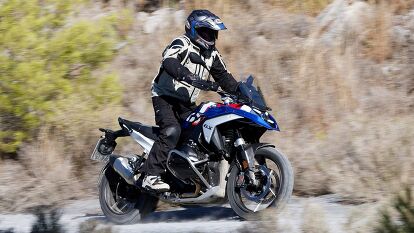
- Helmet: Arai XD-4
- Jacket: Alpinestars Ardent
- Pants: Alpinestars Ardent
- Gloves: Alpinestars AMT-10 Air HDry
- Boots: Alpinestars Tech 7 Enduro Drystar
2024 BMW R 1300 GS Specifications | |
|---|---|
MSRP | R 1300 GS: Starts at $18,895 R 1300 GS - Triple Black: Starts at $19,870 R 1300 GS - GS Trophy: Starts at $19,870 R 1300 GS - Option 719 Tramauntana: Starts at $22,090 |
Engine Type | Air/liquid-cooled 2-cylinder 4-stroke boxer, OHV / 4-valves per cylinder |
Displacement | 1,300cc |
Bore x Stroke | 106.5mm x 73mm |
Compression / Fuel | 13.3:1 / premium unleaded |
Valve Diameter | 44.0 mm intake / 35.6 mm exhaust |
Throttle Body Diameter | 52 mm |
Horsepower | 145 hp at 7,750 rpm (claimed) |
Torque | 105 lb-ft. at 6,500 rpm (claimed) |
Engine Control | BMS-O |
Alternator | 650 W |
Battery | 12V / 10 Ah maintenance-free |
Headlight | LED low and high beam |
Clutch | Hydraulically activated, anti-hopping wet clutch |
Gearbox | Constant-mesh 6-speed gearbox |
Primary Ratio | 1.479 |
Transmission Ratio | 2.91 |
Drive | Universal shaft |
Frame | Steel, two-section with bolt on rear frame |
Front Suspension | EVO Telelever, 7.5 inches of travel |
Rear Suspension | EVO Paralever with cast aluminum single sided swing arm, 7.9 inches of travel |
Rake/Trail | 26.2° / 4.4 inches |
Wheelbase | 59.8 inches |
Front Brake | Twin disc brake Ø 310 mm 4-piston radial calipers |
Rear Brake | Single-disc brake Ø 285 mm, 2-piston floating calipers |
Abs | BMW Motorrad ABS Pro |
Front Wheel | 3.00 x 19" light alloy cast wheels (wire spoke available) |
Rear Wheel | 4.5 x 17" light alloy cast wheels (wire spoke available) |
Front Tire | 120/70 R 19 |
Rear Tire | 170/60 R 17 |
Length | 87.1 inches |
Width | 39.4 inches |
Seat Height | 33.5 inches |
Curb Weight | 523 pounds (claimed) |
Fuel Capacity | 5.0 gallons |
We are committed to finding, researching, and recommending the best products. We earn commissions from purchases you make using the retail links in our product reviews. Learn more about how this works.
Become a Motorcycle.com insider. Get the latest motorcycle news first by subscribing to our newsletter here.

Ryan’s time in the motorcycle industry has revolved around sales and marketing prior to landing a gig at Motorcycle.com. An avid motorcyclist, interested in all shapes, sizes, and colors of motorized two-wheeled vehicles, Ryan brings a young, passionate enthusiasm to the digital pages of MO.
More by Ryan Adams



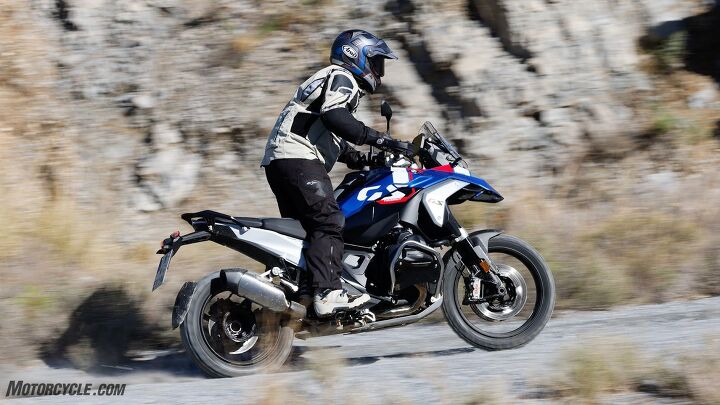














































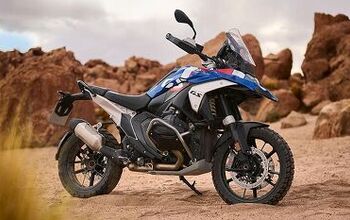
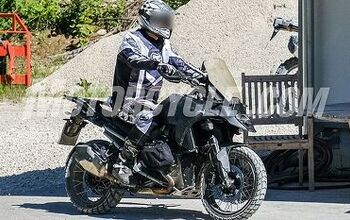
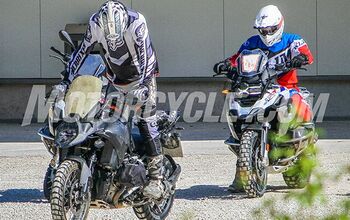

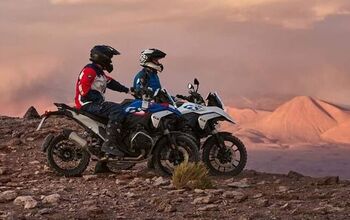













Comments
Join the conversation
I have owned a 2019 BMW 1250 GSA for about three years now. Love the bike. But I admit, it is heavy - a plus when on highway, but not so much for offroad. Suspensions needs to be reworked for larger bodies such as myself - 6'3" 210 lbs. But with a change to the ralley seat and bar risers installed, it is comfortable for long rides. That being said, it also has a 7.9 gallon tank which gives appx 320-340 miles range depending on how hard you run it. The new 5.0 gallon tank on the 2024 seems a bit small for range - 40 mpg x 5 gallons = 200 miles? Also is the argument of the tried and true steel tubular frame vs. new sheetmetal frame - I would let that one guniea pig out for a few years. Overall, the 2019 ride is extremely well balanced, almost like an old spin top toy that won't fall over as the center of gravity is so low. True off-roading with he bike can be a challenge though as once you get high or low sided, she can be a bear to upright, and the heads sticking out of the sides of the engine don't get along well with hills, big ruts, or single track type trails. She's meant for "mild' off roads like gravel and forest fire roads. Maybe the new one is more capable there? IDK. Would love to test ride one! P.S. The more you ride your bike, the more you'll like it, whatever one you have. 🦅🇺🇸🚀
I have seen the 1300 GS up close on a couple of occasions. It looks fantastic. My only issue is that I don't want all the electronic crap. Just more to go wrong. I really wish BWM ( and others) would make a big displacement BASIC motorcycle. Right now I have a BMW 1200 R...no safety nannies (other than ABS)...it's just a basic bike and it's fantastic. I'm able to work on it myself. Guess I'll keep 'er until she dies...Bike is already 11 years old and still runs like new.